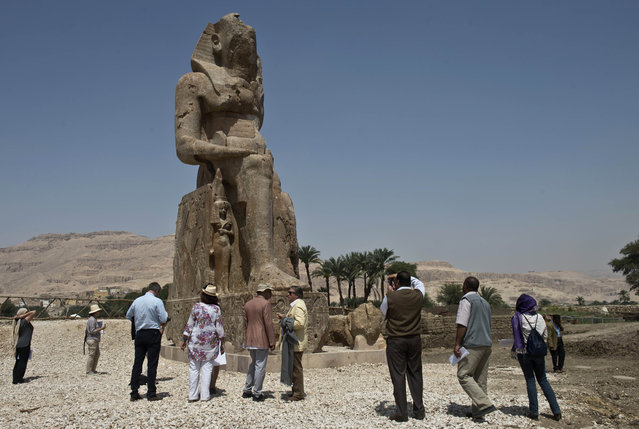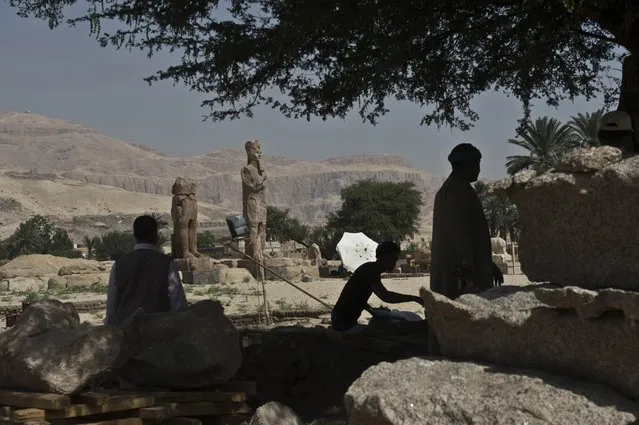Archaeologists on Sunday unveiled two colossal statues of Pharaoh Amenhotep III in Egypt’s famed temple city of Luxor, adding to an existing pair of world-renowned tourist attractions. The two monoliths in red quartzite were raised at what European and Egyptian archaeologists said were their original sites in the funerary temple of the king, on the west bank of the Nile.
The temple is already famous for its existing 3,400-year-old Memnon colossi – twin statues of Amenhotep III whose reign, archaeologists say, marked the political and cultural zenith of ancient Egyptian civilization. “The world until now knew two Memnon colossi, but from today it will know four colossi of Amenhotep III”, said German-Armenian archaeologist Hourig Sourouzian, who heads the project to conserve the Amenhotep III temple.
The existing two statues, both showing the pharaoh seated, are known across the globe. The two restored additions have weathered severe damage for centuries, Sourouzian said. “The statues had lain in pieces for centuries in the fields, damaged by destructive forces of nature like earthquakes, and later by irrigation water, salt, encroachment and vandalism”, she said as behind her excavators and local villagers washed pieces of artifacts and statues that have been unearthed over the past months.
The temple is already famous for its existing 3,400-year-old Memnon colossi – twin statues of Amenhotep III whose reign, archaeologists say, marked the political and cultural zenith of ancient Egyptian civilization. “The world until now knew two Memnon colossi, but from today it will know four colossi of Amenhotep III”, said German-Armenian archaeologist Hourig Sourouzian, who heads the project to conserve the Amenhotep III temple.
The existing two statues, both showing the pharaoh seated, are known across the globe. The two restored additions have weathered severe damage for centuries, Sourouzian said. “The statues had lain in pieces for centuries in the fields, damaged by destructive forces of nature like earthquakes, and later by irrigation water, salt, encroachment and vandalism”, she said as behind her excavators and local villagers washed pieces of artifacts and statues that have been unearthed over the past months.

Tourists and journalists stand next to a newly displayed statue of pharaoh Amenhotep III and his wife Tiye (Down) in Egypt's temple city of Luxor on March 23, 2014. Two colossal statues of pharaoh Amenhotep III were unveiled by archaeologists today in their original sites in the funerary temple of the king, on the west bank of the Nile in Luxor, adding to the existing two famous ancient Memnon colossi. (Photo by Khaled Desouki/AFP Photo)

A picture taken on March 23, 2014 shows newly displayed statues of pharaoh Amenhotep III in Egypt's temple city of Luxor on March 23, 2014. (Photo by Khaled Desouki/AFP Photo)

A picture taken on March 23, 2014 shows a part of a newly displayed statue of pharaoh Amenhotep III and his wife Tiye (Down) in Egypt's temple city of Luxor on March 23, 2014. (Photo by Khaled Desouki/AFP Photo)
25 Mar 2014 09:02:00,
post received
0 comments
